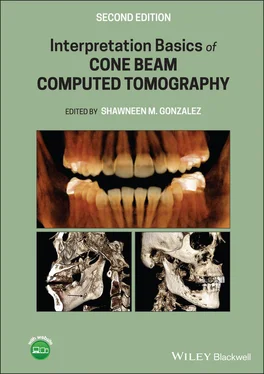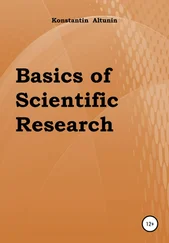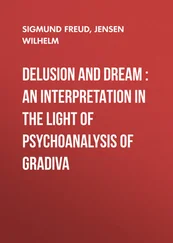1 Cover
2 Title Page
3 Copyright Page
4 Preface to the Second Edition
5 Acknowledgments
6 About the Companion Website
7 1 Introduction to Cone Beam Computed Tomography Introduction Conventional Computed Tomography Cone Beam Computed Tomography Conventional CT versus Cone Beam CT Viewing CBCT Data Artifacts References
8 2 Cone Beam Computed Tomography Recommendations Introduction Endodontics Orthodontics Periodontics References
9 3 Legal Issues Concerning Cone Beam Computed Tomography Introduction Standard of Care Recommendations Summary References
10 4 Paranasal Sinuses and Mastoid Air Cells Introduction Anatomy Inflammatory Disease of the Paranasal Sinuses Postsurgical Changes of Paranasal Sinuses References
11 5 The Sinonasal Cavity and Airway Introduction Anatomy Surgical Variations Inflammatory Diseases The Pharynx The Nasopharynx The Oropharynx The Hypopharynx (Also Called Laryngopharynx) The Parapharyngeal Space References
12 6 Cranial Skull Baseand Orbits Introduction Anatomy Anatomic Variants/Developmental Anomalies Incidental Findings References
13 7 Soft Tissues Introduction Pathosis—Arterial Calcifications Pathosis—Other Calcifications Incidental Findings—Soft Tissue of the Brain Incidental Findings—Orbital Cavity Incidental Findings—Face References
14 8 Cervical Spine Introduction Anatomy Anatomic Variants/Developmental Anomalies Pathosis References
15 9 Maxilla and Mandible (excluding TMJs) Introduction Anatomy Anatomic Variants/Developmental Anomalies Pathosis Incidental Findings References
16 10 Temporomandibular Joints Introduction Normal Anatomy and Function Developmental Abnormalities Soft‐Tissue Abnormalities Remodeling and Arthritis Trauma Tumors References
17 11 Implants Introduction Imaging for Implant Purposes CBCT Image Development Gray Values and Hounsfield Units Bone Density: A Key Determinant for Treatment Planning Linear Measurement Accuracy Mandibular Canal Virtual Implant Placement Software References
18 Appendix AppendixSample Reports Introduction General Health Report Pathology Report Endodontic Report
19 Index
20 End User License Agreement
1 Chapter 4Table 4.1. Anatomical landmarks identifiable in corresponding figures.
2 Chapter 6Table 6.1. Cranial skull base anatomical landmarks with corresponding figure ...
3 Chapter 8Table 8.1 Radiographic degenerative joint disease (DJD) classification.
4 Chapter 9Table 9.1. Maxilla and mandible anatomical landmarks with corresponding figur...
5 Chapter 11Table 11.1. Hounsfield units for various tissues frequently captured on a CBC...Table 11.2. Hounsfield units for various bone densities as captured on a CBCT...
1 Chapter 1 Figure 1.1. (a) 3D rendering of a small FOV of 5 cm × 8 cm from an anteropos... Figure 1.2. Axial (A), coronal (C), sagittal (S), and reconstructed 3D views... Figure 1.3. (a) 3D rendering of a medium FOV of 8 cm × 8 cm from an anteropo... Figure 1.4. Axial (A), coronal (C), sagittal (S), and reconstructed 3D views... Figure 1.5. (a) 3D rendering of a large FOV of 16 cm × 16 cm from an anterop... Figure 1.6. Axial (A), coronal (C), sagittal (S), and reconstructed 3D views... Figure 1.7. Axial (A), coronal (C), sagittal (S), and reconstructed 3D views... Figure 1.8. Reconstructed pantomograph from a CBCT scan. Figure 1.9. Reconstructed lateral cephalometric skull. Figure 1.10. Cross‐sectional slices with axial view and reconstructed pantom... Figure 1.11. Temporomandibular joint view with rotated sagittal cross‐sectio... Figure 1.12. (a) 3D rendered view with teeth setting. (b) 3D rendered view w... Figure 1.13. Maximum Intensity Projection (MIP) view. Figure 1.14. (a) Axial view showing streak artifact (black arrow) and beam h... Figure 1.15. Axial view with metallic streak artifact (black arrow), beam ha... Figure 1.16. (a) Sagittal view showing motion artifact of the cervical verte... Figure 1.17. Axial (A), coronal (C), and sagittal (S) views with motion arti... Figure 1.18. (a) Coronal view showing white ring artifacts (black arrow). (b...
2 Chapter 2 Figure 2.1. (a) Sagittal view showing a distal dilaceration of the mesio‐buc... Figure 2.2. Coronal view showing a maxillary premolar with an unfilled palat... Figure 2.3. (a) Coronal view showing localized vertical bone loss (white arr... Figure 2.4. (a) Pantomograph showing impacted maxillary right canine. (b) Pe... Figure 2.5. (a) Cross‐sectional slices showing a horizontal root fracture (w... Figure 2.6. Axial views showing artifact streaking from an endodontically tr... Figure 2.7. Sagittal views showing the extent of invasive cervical resorptio... Figure 2.8. Axial (A), coronal (C) and sagittal (S) views showing the extent... Figure 2.9. (a) Rotated sagittal views showing a bone defect (white arrow) o... Figure 2.10. (a) Axial (A), coronal (C), and sagittal (S) views showing a th... Figure 2.11. Reconstructed pantomograph and cross‐sectional slices showing l... Figure 2.12. Cross‐sectional slices of an impacted maxillary canine with ext... Figure 2.13. (a) Axial view showing a bilateral cleft palate (white arrows).... Figure 2.14. (a) Cross‐sectional slices showing a supernumerary tooth positi... Figure 2.15. (a) Periapical radiographs showing a well‐defined, corticated r... Figure 2.16. (a) Bitewing radiographs showing bone loss (white arrow) in the... Figure 2.17. Reconstructed pantomograph and cross‐sectional slices showing l... Figure 2.18. Reconstructed pantomograph and cross‐sectional slices showing f...
3 Chapter 4Figure 4.1. Coronal view showing the left frontal sinus (FS) and left maxill...Figure 4.2. Coronal view showing the frontal sinuses (FS), maxillary sinuses...Figure 4.3. Coronal view showing the ethmoid air cells (EAC), ostiomeatal un...Figure 4.4. Coronal view showing the ethmoid air cells (EAC) and maxillary s...Figure 4.5. Coronal view showing the sphenoid sinuses (SS) with bilateral pt...Figure 4.6. Coronal view showing the posterior aspect of the sphenoid sinuse...Figure 4.7. Coronal view showing the mastoid air cells (MAC). Yellow line sh...Figure 4.8. Axial view showing the ethmoid air cells (EAC) and sphenoid sinu...Figure 4.9. Axial view showing the maxillary sinuses (MS), sphenoid sinuses ...Figure 4.10. Axial view showing the nasolacrimal ducts (NLD), infraorbital c...Figure 4.11. Axial view showing the maxillary sinuses (MS) and mastoid air c...Figure 4.12. Sagittal view showing the mastoid air cells (MAC). Yellow line ...Figure 4.13. Sagittal view showing mastoid air cells (MAC), maxillary sinus ...Figure 4.14. Sagittal view showing the maxillary sinus (MS) and a pterygoid ...Figure 4.15. Sagittal view showing the sphenoid sinuses (SS), ethmoid air ce...Figure 4.16. Sagittal view on the midline showing the sphenoid sinuses (SS) ...Figure 4.17. (a) Coronal view showing a patent ostiomeatal unit (OMU). (b) C...Figure 4.18. Coronal view showing the nasolacrimal duct (NLD) draining into ...Figure 4.19. (a) Coronal view showing bilateral Haller cells (white arrows) ...Figure 4.20. (a) Coronal view showing Onodi cell (ONC) superior to the left ...Figure 4.21. Coronal view showing a left ethmoid bulla (EB).Figure 4.22. (a) Coronal view showing minimal thickening of the mucosal lini...Figure 4.23. (a) Sagittal view showing minimal thickening of the mucosal lin...Figure 4.24. (a) Coronal view showing partial radiopacification of the right...Figure 4.25. Coronal view showing radiopacification of the left maxillary si...Figure 4.26. Coronal view showing thickened bone border (white arrow) of the...Figure 4.27. (a) Coronal view showing an air‐fluid level (white arrow) of th...Figure 4.28. (a) Coronal view showing a radiopaque dome‐shaped entity on the...Figure 4.29. Sagittal view showing multiple retention pseudocysts versus sin...Figure 4.30. Axial (A), coronal (C), and sagittal (S) views showing a large ...Figure 4.31. Axial (A), coronal (C), and sagittal (S) views showing multiple...Figure 4.32. (a) Coronal view showing a calcified entity (white arrow) in th...Figure 4.33. (a) Axial view showing a calcified entity (white arrow) in the ...Figure 4.34. (a) Sagittal view showing a mucocele (white arrows) of the ethm...Figure 4.35. Coronal view showing bilateral uncinectomy (white arrows) creat...
Читать дальше












